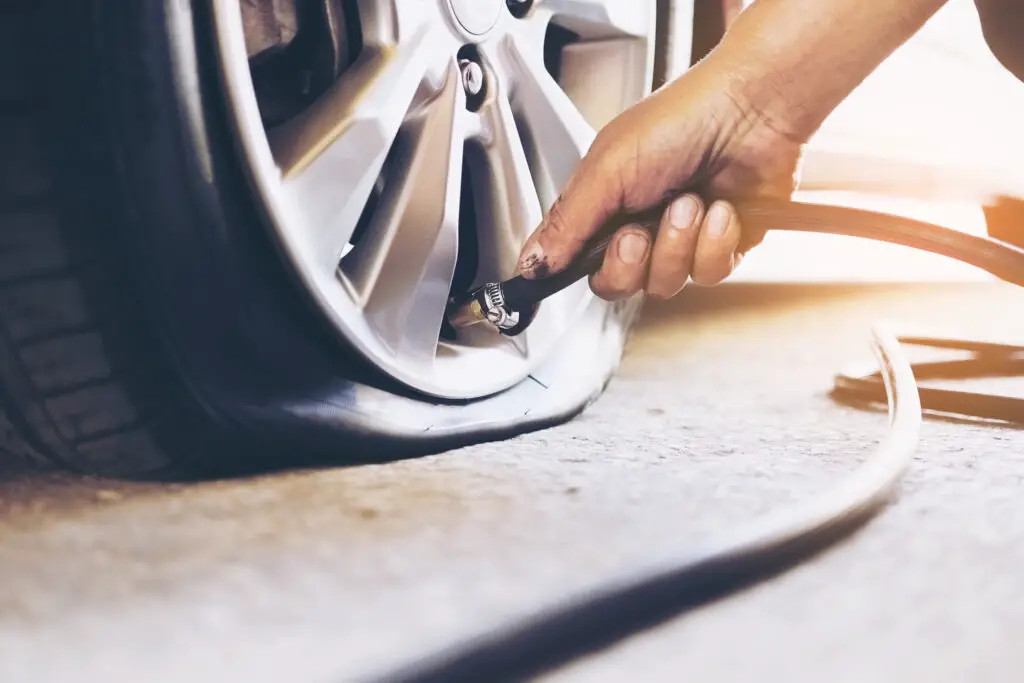What to do when you have a flat tire? Getting a flat tire is never fun. It can be inconvenient, frustrating, and sometimes even dangerous if it happens at the wrong time.
But with the right know-how, you can handle it like a pro. Whether you’re stuck on a busy highway or a deserted road, this guide will walk you through what to do when you have a flat tire.
1. Stay Calm and Get to Safety
The first thing you want to do is stay calm and think clearly. If you notice your car pulling to one side, hear a thumping noise, or feel unusual vibrations, you might have a flat. Here’s what you should do next:
- Pull Over Safely: Find a level spot away from traffic. If you’re on a highway, aim for the right shoulder. Never stop on a curve or narrow area.
- Turn On Hazard Lights: Hit those hazards to alert other drivers that you’re having an issue.
- Check the Tire: Once you’re safely off the road, check which tire is flat and look for any visible damage like punctures or bulges.
2. Gather Your Tools and Gear
Before you start, make sure you’ve got everything you need. Here’s what should be in your trunk:
- Spare Tire: Double-check it’s in good shape and properly inflated.
- Jack: This lifts your car off the ground. Know where the jacking points are on your vehicle.
- Lug Wrench: You’ll use this to loosen and tighten the lug nuts. A cross-pattern wrench gives better leverage.
- Wheel Chocks: These prevent the car from rolling while you’re working.
- Owner’s Manual: Always have this handy. It’s your go-to for specific instructions about your vehicle.
3. Prep Your Vehicle
Get everything ready before you start the actual tire change:
- Engage the Parking Brake: This keeps your car from rolling.
- Set Wheel Chocks: Place them behind the opposite wheels to add stability.
- Remove Hubcaps or Covers: If your wheels have hubcaps, gently pop them off to expose the lug nuts.
4. Loosen the Lug Nuts
Before jacking up the car, it’s easier to break the lug nuts loose while the car is still on the ground:
- Loosen the Nuts (Don’t Remove Them Yet): Use your lug wrench to turn them counterclockwise. If they’re tight, apply extra force or use your body weight.
5. Lift the Vehicle with the Jack
Once the lug nuts are loose, it’s time to lift the car:
- Position the Jack: Follow your owner’s manual to find the right jacking point.
- Raise the Vehicle: Crank the jack until the tire is completely off the ground. Make sure there’s enough clearance to swap the tire.
6. Remove the Flat Tire
Now you can take off the damaged tire:
- Remove the Lug Nuts: Fully unscrew the lug nuts and keep them safe—you’ll need them in a minute.
- Take Off the Flat Tire: Pull it straight off the hub. If it’s stuck, a little wiggle or tap should do the trick.

7. Install the Spare Tire
Here’s how to put on the spare:
- Align the Spare Tire: Slide the spare onto the hub, lining up the holes with the lug bolts.
- Hand-Tighten the Lug Nuts: Start threading the nuts by hand. Get them snug, but don’t fully tighten them yet.
8. Lower the Car and Tighten the Lug Nuts
With the spare on, carefully lower the car back to the ground:
- Lower the Vehicle: Turn the jack handle to slowly bring the car down. Once it’s stable, remove the jack.
- Tighten the Lug Nuts: Use a crisscross pattern to tighten the nuts evenly. This ensures the wheel is secure.
9. Check the Spare and Secure Your Tools
Before hitting the road, make sure everything’s in order:
- Check Tire Pressure: Make sure the spare is properly inflated. Temporary spares often have specific speed limits—stick to them.
- Pack Up Safely: Stow the flat tire, jack, and other tools securely in your trunk.
10. Head to a Repair Shop ASAP
Spare tires are meant to be temporary, so don’t push your luck:
- Drive Cautiously: If you’re using a donut spare, keep speeds below 50 mph and avoid long distances.
- Get the Flat Repaired or Replaced: Head to a tire shop where they can either repair your tire or recommend a replacement.
Prevent Future Flats
While flats can’t always be avoided, these tips can help you minimize the chances:
- Regularly Check Tire Pressure: Under-inflated tires are more prone to damage.
- Inspect for Damage: Keep an eye out for cracks, punctures, and uneven wear.
- Rotate Tires Regularly: This promotes even tread wear, extending tire life.
- Avoid Road Hazards: Steer clear of debris and potholes whenever possible.
- Carry a Repair Kit: A tire repair kit can be a lifesaver in a pinch.
Conclusion
Dealing with a flat tire isn’t fun, but knowing what to do can make a big difference. With the right tools and a little know-how, you can get back on the road in no time. And remember—if you’re ever in doubt or don’t have the necessary tools, roadside assistance is always a call away.
Discover more from Chikwem
Subscribe to get the latest posts sent to your email.